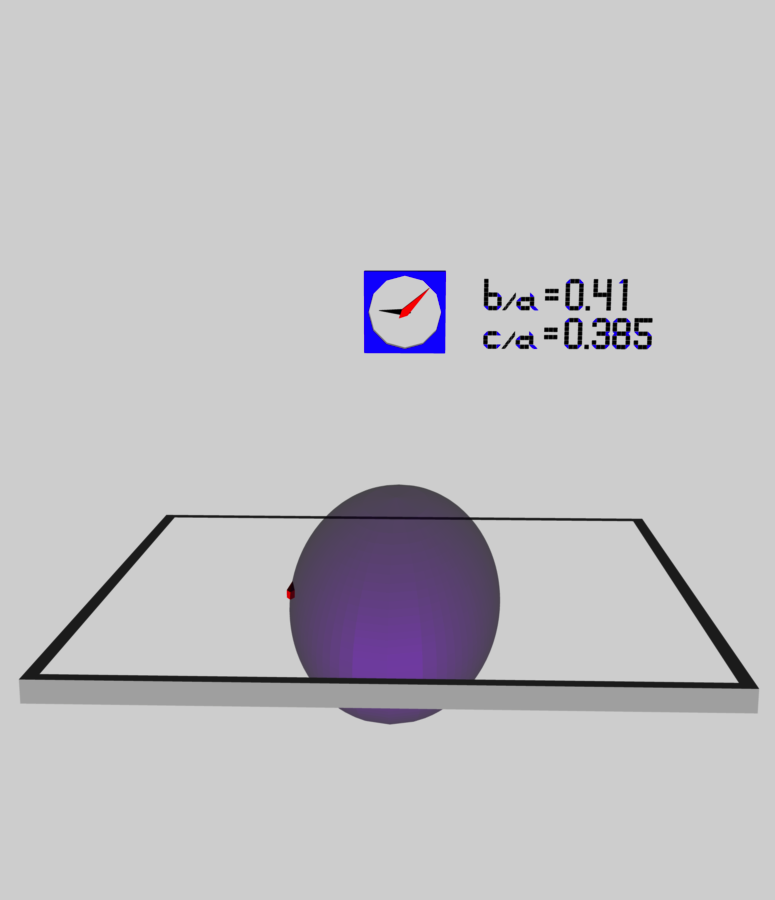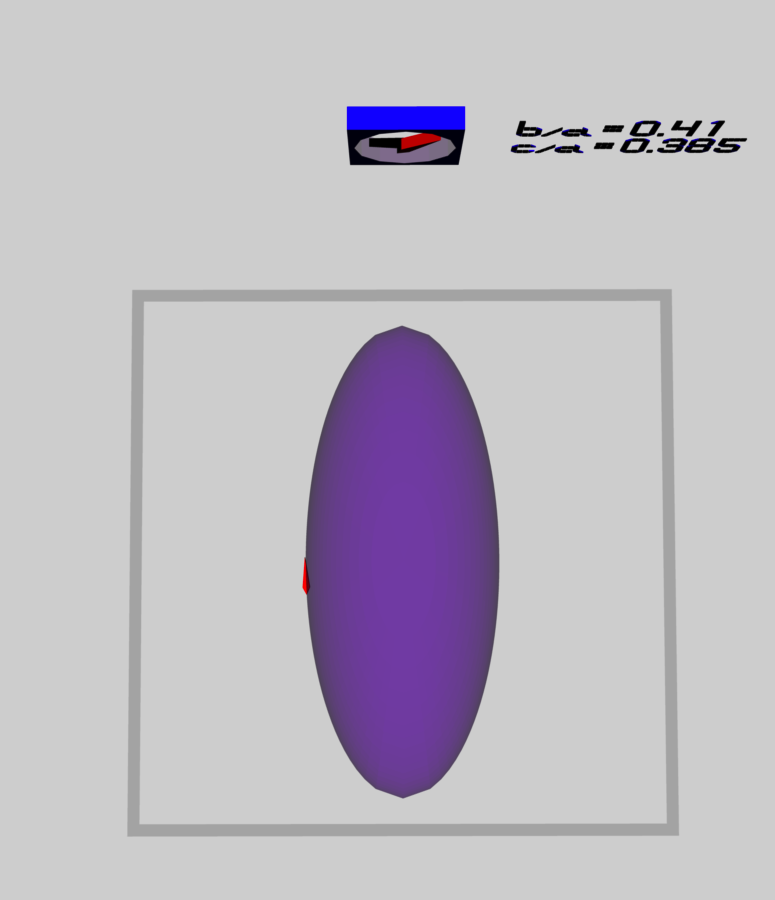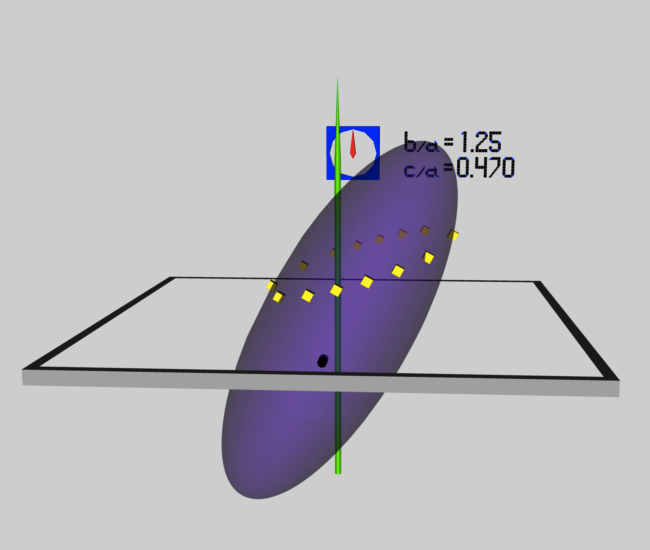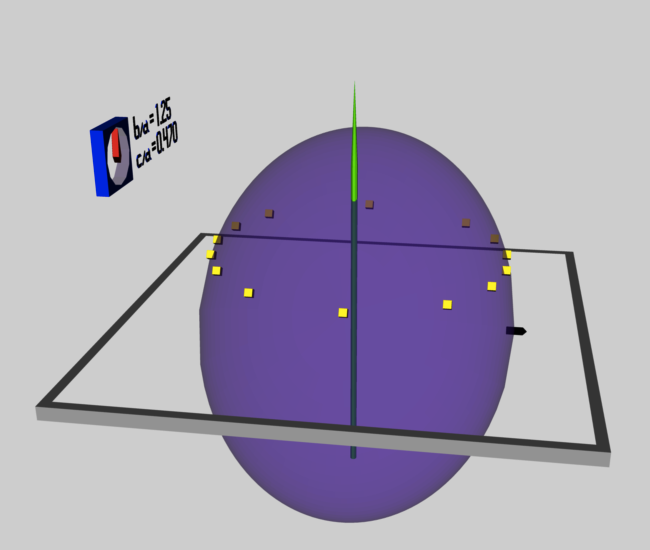User:Tohline/ThreeDimensionalConfigurations/RiemannStype
Riemann S-type Ellipsoids

|
|---|
| | Tiled Menu | Tables of Content | Banner Video | Tohline Home Page | |
General Coefficient Expressions
As has been detailed in an accompanying chapter, the gravitational potential anywhere inside or on the surface, <math>~(a_1,a_2,a_3) ~\leftrightarrow~(a,b,c)</math>, of an homogeneous ellipsoid may be given analytically in terms of the following three coefficient expressions:
|
<math> ~A_1 </math> |
<math> ~= </math> |
<math>~2\biggl(\frac{b}{a}\biggr)\biggl(\frac{c}{a}\biggr) \biggl[ \frac{F(\theta,k) - E(\theta,k)}{k^2 \sin^3\theta} \biggr] \, , </math> |
|
<math> ~A_3 </math> |
<math> ~= </math> |
<math> ~2\biggl(\frac{b}{a}\biggr) \biggl[ \frac{(b/a) \sin\theta - (c/a)E(\theta,k)}{(1-k^2) \sin^3\theta} \biggr] \, , </math> |
|
<math> ~A_2 </math> |
<math> ~= </math> |
<math>~2 - (A_1+A_3) \, ,</math> |
where, <math>~F(\theta,k)</math> and <math>~E(\theta,k)</math> are incomplete elliptic integrals of the first and second kind, respectively, with arguments,
|
<math>~\theta = \cos^{-1} \biggl(\frac{c}{a} \biggr)</math> |
and |
<math>~k = \biggl[\frac{1 - (b/a)^2}{1 - (c/a)^2} \biggr]^{1/2} \, .</math> |
| [ EFE, Chapter 3, §17, Eq. (32) ] | ||
| TEST (part 1) Notation: Use <math>~\phi</math> in place of <math>~\theta</math>. |
||||||||||
| <math>~\frac{b}{a}</math> | <math>~\frac{c}{a}</math> | <math>~\phi</math> | <math>~k</math> | Numerical Recipes | <math>~A_1</math> | <math>~A_2</math> | <math>~A_3</math> | |||
| (deg) | (rad) | (deg) | (rad) | <math>~F(\phi,k) </math> | <math>~E(\phi,k) </math> | |||||
| 0.9 | 0.641 | 50.13357253 | 0.874995907 | 32.53852919 | 0.567904468 | 0.909025949 | 0.843118048 | 0.521450273 | 0.595131012 | 0.883418715 |
Equilibrium Conditions for Riemann S-type Ellipsoids
Pulling from Chapter 7 — specifically, §48 — of Chandrasekhar's EFE, we understand that the semi-axis ratios, <math>~(\tfrac{b}{a}, \tfrac{c}{a})</math> associated with Riemann S-type ellipsoids are given by the roots of the equation,
|
<math>~ \biggl[ \frac{a^2 b^2}{a^2 + b^2} \biggr] f \biggl( \frac{\Omega^2}{\pi G \rho} \biggr) </math> |
<math>~=</math> |
<math>~a^2 b^2 A_{12} - c^2 A_3 \, ,</math> |
| [ EFE, §48, Eq. (34) ] | ||
and the associated value of the square of the equilibrium configuration's angular velocity is,
|
<math>~\biggl[ 1 + \frac{a^2 b^2 \cdot f^2}{(a^2 + b^2)^2} \biggr] \frac{\Omega^2}{\pi G \rho}</math> |
<math>~=</math> |
<math>~2B_{12} \, ,</math> |
| [ EFE, §48, Eq. (33) ] | ||
where,
|
<math>~A_{12}</math> |
<math>~\equiv</math> |
<math>~-\frac{A_1-A_2}{(a^2 - b^2)} \, ,</math> |
| [ EFE, §21, Eq. (107) ] | ||
|
<math>~B_{12}</math> |
<math>~\equiv</math> |
<math>~A_2 - a^2A_{12} \, .</math> |
| [ EFE, §21, Eq. (105) ] | ||
(Notice that if we set <math>~f \rightarrow 0</math>, this pair of expressions simplifies to the pair we have provided in a separate discussion of the equilibrium conditions for Jacobi ellipsoids.) Following Chandrasekhar's lead and eliminating <math>~\Omega^2</math> between these two expressions, we obtain,
|
<math>~0</math> |
<math>~=</math> |
<math>~ \biggl[ \frac{a^2 b^2}{(a^2 + b^2)^2} \biggr] f^2 + \biggl[ \frac{2a^2 b^2 B_{12}}{c^2 A_3 - a^2 b^2 A_{12}} \biggr]\frac{f}{a^2 + b^2} + 1 \, . </math> |
| [ EFE, §48, Eq. (35) ] | ||
For a given <math>~f</math>, this last expression determines the ratios of the axes of the ellipsoids that are compatible with equilibrium; and the value of <math>~\Omega^2</math>, that is to be associated with a particular solution of this last expression, then follows from either one of the first two expressions. For convenience of evaluation and for greater clarity, let's rewrite this last (quadratic) equation in the form,
|
<math>~0</math> |
<math>~=</math> |
<math>~ \alpha f^2 + \beta f + 1 \, , </math> |
in which case the pair of solutions is,
|
<math>~f</math> |
<math>~=</math> |
<math>~ \frac{1}{2\alpha}\biggr\{ - \beta \pm \biggl[ \beta^2 - 4\alpha \biggr]^{1 / 2} \biggr\} \, ; </math> |
and the corresponding values of the angular velocity (in units of [G ρ]½) are provided by the expression,
|
<math>~\omega \equiv \frac{\Omega}{\sqrt{G\rho}}</math> |
<math>~=</math> |
<math>~ \pm \biggl\{ 2 \pi B_{12} \biggl[ 1 + \alpha f^2 \biggr]^{-1} \biggr\}^{1 / 2} </math> |
| TEST (part 2) | |||||||||
| <math>~\frac{b}{a}</math> | <math>~\frac{c}{a}</math> | <math>~a^2 A_{12}</math> | <math>~ B_{12}</math> | <math>~\alpha \equiv \frac{(b/a)^2}{[ 1 + (b/a)^2]^2} </math> | <math>~\beta \equiv \biggl[ \frac{2 B_{12}}{(c/b)^2 A_3 - a^2 A_{12}} \biggr]\frac{1}{1 + (b/a)^2} </math> | Direct | Adjoint | ||
| <math>~f </math> | <math>~\omega = \frac{\Omega}{\sqrt{G\rho}} </math> | <math>~f^\dagger </math> | <math>~\omega^\dagger = \frac{\Omega^\dagger}{\sqrt{G\rho}} </math> | ||||||
| 0.9 | 0.641 | 0.387793362 | 0.207337649 | 0.247245200 | 3.797483556 | - 0.268008879 | ± 1.131374734 | -15.09117122 | ± 0.150771618 |
Now, according to Ou (2006), at any coordinate position inside or on the surface of the ellipsoid, <math>~(x, y)</math>, the three components of the velocity as viewed from a frame of rotation that is spinning at the equilibrium configuration's frequency, <math>~\Omega</math>, are,
|
<math>~\vec{v}</math> |
<math>~=</math> |
<math>~\lambda \biggl( \frac{ay}{b} , - \frac{bx}{a} , 0 \biggr) \, ,</math> |
where, <math>~\lambda</math> is an overall scale factor. But, according to §48 of EFE, we see that,
|
<math>~\vec{u}</math> |
<math>~=</math> |
<math>~\biggl( Q_1 y , Q_2 x , 0 \biggr) \, ,</math> |
where,
|
<math>~Q_1</math> |
<math>~\equiv</math> |
<math>~- \biggl[ \frac{a^2}{a^2 + b^2} \biggr]\zeta</math> |
and, |
<math>~Q_2</math> |
<math>~\equiv</math> |
<math>~+ \biggl[ \frac{b^2}{a^2 + b^2} \biggr]\zeta \, ,</math> |
and <math>~\zeta</math> is the scalar magnitude of the vorticity vector, <math>~\vec\zeta</math>. The transformation from EFE's notation to the one used by Ou is, then,
|
<math>~\lambda \biggl( \frac{a}{b} \biggr) </math> |
<math>~=</math> |
<math>~- \biggl[ \frac{a^2}{a^2 + b^2} \biggr]\zeta</math> |
and, |
<math>~- \lambda \biggl( \frac{b}{a} \biggr) </math> |
<math>~=</math> |
<math>~+ \biggl[ \frac{b^2}{a^2 + b^2} \biggr]\zeta </math> |
|
<math>~\Rightarrow ~~~ \lambda </math> |
<math>~=</math> |
<math>~- \biggl[ \frac{a b}{a^2 + b^2} \biggr]\zeta = - \biggl[ \frac{b}{a} + \frac{a}{b} \biggr]^{-1} \zeta\, ,</math> |
which, gratifyingly agrees with Ou's equation (17).
Models Examined by Ou (2006)
His Tabulated Model Parameters
Table 1 (see below) lists a subset of the Riemann S-type ellipsoids that were studied by Ou (2006); properties of various so-called Direct configurations can be found in Ou's Table 1, while properties of various Adjoint configurations can be found in his Table 5. Each row of our Table 1 was constructed as follows:
- The pair of axis ratios <math>~(\tfrac{b}{a}, \tfrac{c}{a} )</math> associated with one of Ou's (2006) uniform-density, incompressible <math>~(n=0)</math> ellipsoid models (columns 1 and 2 from Ou's Table 1) has been copied into columns 1 and 2 of our table.
- Properties of Direct Configurations …
- The pair of parameter values <math>~(\omega_\mathrm{analytic}, \lambda_\mathrm{analytic})</math> that is required in order for this to be an equilibrium configuration — as specified by the above set of analytical expressions from EFE — is copied from, respectively, columns 11 and 13 of Ou's Table 1 into columns 3 and 4 of our table; in our table, the "analytic" subscript has been dropped from the column headings.
- The value of the equilibrium configuration's vorticity, <math>~\zeta</math> — see column 5 of our table — has been determined from the expression,
<math>~\zeta = - \biggl[ \frac{1 + (b/a)^2}{b/a} \biggr] \lambda \, .</math> - Column 6 of our table lists the value of the frequency ratio, <math>~f \equiv \zeta/\omega</math>.
- Properties of Adjoint Configurations [in order to distinguish from Direct configuration properties, a superscript † has been attached to each parameter name] …
- As listed in column 7 of our Table, the "spin" angular velocity of the adjoint equilibrium configuration has been determined from the vorticity of the direct configuration via the relation,
<math>~\omega^\dagger = \zeta \biggl[\frac{b/a}{1 + (b/a)^2}\biggr] \, .</math> - As listed in column 10 of our Table, the ratio <math>~(f^\dagger)</math> of the vorticity to the angular velocity in the adjoint equilibrium configuration has been determined from the same ratio <math>~(f)</math> in the direct configuration via the relation,
<math>~f^\dagger = \frac{1}{f} \biggl\{ \frac{[1 + (b/a)^2]^2}{(b/a)^2} \biggr\} \, .</math> - As indicated, the value of the vorticity in the adjoint equilibrium configuration (column 9 of our table) has been determined from a product of <math>~\omega^\dagger</math> and <math>~f^\dagger</math>.
- As listed in column 8 of our table, the value of the parameter, <math>~\lambda^\dagger</math>, has been determined from the vorticity in the adjoint equilibrium configuration via the relation,
<math>~\lambda^\dagger = -~ \zeta^\dagger \biggl[ \frac{b}{a} + \frac{a}{b}\biggr]^{-1} \, .</math>
|
Table 1: Example Riemann S-type Ellipsoids |
|||||||||
| <math>~\frac{b}{a}</math> | <math>~\frac{c}{a}</math> |
Properties of |
Properties of |
||||||
| <math>~\omega = \frac{\Omega}{\sqrt{G \rho}}</math> | <math>~\lambda</math> | <math>~\zeta </math> | <math>~f \equiv \frac{\zeta}{\omega}</math> | <math>~\omega^\dagger </math> | <math>~\lambda^\dagger </math> | <math>~\zeta^\dagger = \omega^\dagger f^\dagger</math> | <math>~f^\dagger </math> | ||
| (1) | (2) | (3) | (4) | (5) | (6) | (7) | (8) | (9) | (10) |
| 0.90 | 0.795 | 1.14704 | 0.43181 | -0.86842 | -0.75709 | -0.43181 | -1.14704 | +2.30682 | -5.3422 |
| 0.641 | 1.13137 | 0.15077 | - 0.30322 | - 0.26801 | - 0.15077 | -1.13137 | 2.27531 | - 15.0913 | |
| 0.590 | 1.10661 | 0.06406 | -0.12883 | -0.11642 | -0.06406 | -1.10661 | +2.22552 | -34.7411 | |
| 0.564 | 1.09034 | 0.02033 | -0.04089 | -0.03750 | -0.02033 | -1.09034 | +2.19279 | -107.86 | |
| 0.538 | 1.07148 | - 0.02324 | +0.04674 | +0.04362 | +0.02324 | - 1.07148 | +2.15487 | +92.722 | |
| 0.487 | 1.02639 | - 0.10880 | +0.21881 | +0.21318 | +0.10880 | -1.02639 | +2.06418 | +18.972 | |
| 0.333 | 0.79257 | - 0.39224 | +0.78884 | +0.99529 | +0.39224 | -0.79257 | +1.59395 | +4.06370 | |
| 0.28 | 0.256 | 0.80944 | 0.03668 | -0.14127 | -0.17453 | -0.03668 | -0.80944 | +3.11750 | -84.992 |
| 0.245083 | 0.796512a | 0.0 | 0.0 | 0.0 | 0.0 | … | … | <math>~\infty</math> | |
| 0.231 | 0.77651 | - 0.04714 | +0.18156 | +0.23381 | +0.04714 | -0.77651 | +2.99067 | +63.442 | |
| 0.205 | 0.72853 | - 0.13511 | +0.52037 | +0.71427 | +0.13511 | -0.72853 | +2.80588 | +20.7674 | |
|
aAccording to Table IV (p. 103) of EFE, the square of the angular velocity of this Jacobi ellipsoid is, <math>~\Omega^2/(\pi G\rho) = 0.201946</math>; from this value, we find that, <math>~\omega = \sqrt{\pi} \cdot \sqrt{0.201946} = 0.796512</math>. |
|||||||||
Our Parameter Determinations
The parameter values that have been posted above in our Table 1 are typically given with five digits of precision. This is because, as explained, the values were determined from the analytically determined values, <math>~\omega_\mathrm{analytic}</math> and <math>~\lambda_\mathrm{analytic}</math>, that were provided by Ou (2006) with only five digit accuracy. Our Table 2 (shown immediately below) provides values of this same set of model parameters to better than eleven digits accuracy. We calculated these parameter values by following the steps detailed in earlier subsections of this chapter and, as a foundation, using double-precision versions of Numerical Recipes algorithms to evaluate the special functions, <math>~F(\phi,k)</math> and <math>~E(\phi,k)</math>. As an example, the above pair of brief tables titled, TEST (part 1) and TEST (part 2) detail all of the intermediate steps that were used in order to determine the high-precision parameter values specifically for the model having the axis-ratio pair <math>~(0.9,0.641)</math>. This table of higher precision parameter values was primarily generated in order to convince ourselves that we understood from first principles how to accurately determine the properties of Riemann S-type ellipsoids; the lower-precision parameter values that we derived from Ou's work provided a handy means of cross-checking these "first principles" determinations.
In generating our Table 2, we wondered what the approriate signs were of the various model parameters — especially when part of our objective is to distinguish between direct and adjunct configurations. We took the following approach: First we decided that the spin frequency of every direct configuration should be positive. (Evidently, Ou made this same choice.)
|
Table 2: Example Riemann S-type Ellipsoids (double-precision evaluation) |
|||||||||
| <math>~\frac{b}{a}</math> | <math>~\frac{c}{a}</math> |
Properties of |
Properties of |
||||||
| <math>~\omega = \frac{\Omega}{\sqrt{G \rho}}</math> | <math>~\lambda</math> | <math>~\zeta </math> | <math>~f \equiv \frac{\zeta}{\Omega}</math> | <math>~\omega^\dagger </math> | <math>~\lambda^\dagger </math> | <math>~\zeta^\dagger = \omega^\dagger f^\dagger</math> | <math>~f^\dagger </math> | ||
| (1) | (2) | (3) | (4) | (5) | (6) | (7) | (8) | (9) | (10) |
| 0.90 | 0.795 | +1.147036091720 | +0.431809451699 | -0.868416786194 | -0.757096320116 | -0.431809460593 | -1.147036104571 | +2.306817054749 | -5.342210487323 |
| 0.641 | +1.131374738327 | +0.150771621841 | -0.303218483925 | -0.268008886644 | -0.150771621877 | -1.131374730590 | +2.275320291519 | -15.091170863305 | |
| 0.590 | +1.106612583610 | +0.064060198174 | -0.128832176328 | -0.116420305902 | -0.064060197762 | -1.106612576964 | +2.225520849228 | -34.741086358509 | |
| 0.564 | +1.090339840378 | +0.020334563779 | -0.040895067155 | -0.037506716440 | -0.020334563809 | -1.090339837153 | +2.192794561386 | -107.8358300897 | |
| 0.538 | +1.071485625744 | -0.023236834336 | +0.046731855720 | +0.043614077664 | +0.023236835120 | -1.071485656401 | +2.154876708984 | +92.735376233270 | |
| 0.487 | +1.026387311947 | -0.108799837242 | +0.218808561563 | +0.213183225210 | +0.108799835209 | -1.026387320039 | +2.064178943634 | +18.972261524065 | |
| 0.333 | +0.792566980901 | -0.392440787995 | +0.789242029190 | +0.995804846843 | +0.392440793882 | -0.792566979129 | +1.593940258026 | +4.061606964516 | |
| 0.74 | 0.692 | +1.132149 | +0.385992 | -0.385992 | -1.132149 | ||||
| 0.41 | 0.385 | +0.971082 | +0.141594 | -0.141594 | -0.971082 | ||||
| 0.333 | +0.929630138695 | +0.003311666790 | -0.009435019456 | -0.010149218281 | -0.003311666699 | -0.929630099681 | +2.648538827896 | -799.7601146950 | |
| 0.28 | 0.256 | +0.809436834686 | +0.036676037913 | -0.141255140305 | -0.174510396110 | -0.036676038521 | -0.809436833116 | +3.117488145828 | -85.000678306244 |
| 0.245083 | 0.796512a | 0.0 | 0.0 | 0.0 | 0.0 | … | … | <math>~\infty</math> | |
| 0.231 | +0.776514825339 | -0.047142035397 | +0.181564182043 | +0.233819345828 | +0.047142037070 | -0.776514835457 | +2.990691423416 | +63.440011724689 | |
| 0.205 | +0.728526018042 | -0.135108121071 | +0.520359277725 | +0.714263156392 | +0.135108125079 | -0.728526039364 | +2.805866003036 | +20.767558718483 | |
|
aAccording to Table IV (p. 103) of EFE, the square of the angular velocity of this Jacobi ellipsoid is, <math>~\Omega^2/(\pi G\rho) = 0.201946</math>; from this value, we find that, <math>~\omega = \sqrt{\pi} \cdot \sqrt{0.201946} = 0.796512</math>. |
|||||||||
Feeding a 3D Animation
Initial Thoughts
Let's examine the elliptical trajectory of a Lagrangian particle that is moving in the equatorial plane of a Riemann S-Type ellipsoid. As viewed in a frame that is spinning about the Z-axis at angular frequency, <math>~\Omega</math>, the trajectory is defined by,
|
<math> r^2 </math> |
<math> ~= </math> |
<math>~ \biggl(\frac{x}{a} \biggr)^2 + \biggl(\frac{y}{b}\biggr)^2 \, , </math> |
where <math>~0 < r \le 1</math>. (The surface of the relevant ellipsoid is associated with the value, <math>~r=1</math>.)
Let's choose a pair of axis ratios — for example, <math>~b/a = 0.28</math> and <math>~c/a = 0.231</math> — then, from Table 1 of our above discussion, draw the associated value of either <math>~\lambda</math> or <math>~\zeta</math> that corresponds to the Jacobi-like equilibrium configuration — in this example, <math>~\lambda = -0.04714</math> and <math>~\zeta = +0.18156</math>. Then, for any point <math>~(x,y)</math> inside of the ellipsoid, the fluid's velocity components (as viewed from the rotating frame of reference) are,
|
<math> v_x = \frac{dx}{dt} = \lambda \biggl( \frac{ay}{b} \biggr) = -0.16836 ~y </math> |
and, |
<math>~ v_y = \frac{dy}{dt} = - \lambda \biggl( \frac{bx}{a} \biggr) = + 0.01320~x \, . </math> |
Alternatively, we have,
|
<math> u_x = \frac{dx}{dt} = Q_1 y = - \biggl[ 1 + \frac{b^2}{a^2} \biggr]^{-1}\zeta ~y = -0.16836 ~y </math> |
and, |
<math>~ u_y = \frac{dy}{dt}= Q_2 x = + \biggl[ 1 + \frac{a^2}{b^2} \biggr]^{-1}\zeta ~x = + 0.01320~x \, . </math> |
Now, each Lagrangian fluid element's motion is oscillatory in both the <math>~x</math> and <math>~y</math> coordinate directions. So let's see how this plays out. Suppose,
|
<math> x = x_\mathrm{max} \cos(\varphi t) </math> |
and, |
<math>~ y = y_\mathrm{max} \sin(\varphi t) \, . </math> |
Then,
|
<math> \frac{dx}{dt} = - x_\mathrm{max}\varphi \sin(\varphi t) = - \biggl( \frac{x_\mathrm{max}}{y_\mathrm{max}}\biggr) \varphi y = - \varphi \biggl(\frac{ay}{b}\biggr) </math> |
and, |
<math>~ \frac{dy}{dt} = y_\mathrm{max} \varphi \cos(\varphi t) = + \biggl( \frac{y_\mathrm{max}}{x_\mathrm{max}}\biggr) \varphi x = + \varphi \biggl(\frac{bx}{a}\biggr) \, . </math> |
Hence our functional representation of the time-dependent behavior of both <math>~x</math> and <math>~y</math> works perfectly if, for each orbit inside of or on the surface of the configuration, we set <math>~\varphi = - \lambda</math> and if the ratio <math>~y_\mathrm{max}/x_\mathrm{max} = (b/a)</math>. Hooray!
Preferred Normalizations
Let's do this again, assuming that <math>~x</math> and <math>~y</math> both have units of length and that <math>~t</math> has the unit of time. Then, let's use <math>~a</math> to normalize lengths and use <math>~(\pi G \rho)^{-1 / 2}</math> to normalize time. We therefore have,
|
<math> \frac{x}{a} = \biggl(\frac{ x_\mathrm{max} }{a}\biggr) \cos\biggl[ \frac{\varphi}{(\pi G \rho)^{1 / 2}} \cdot \frac{t}{(\pi G \rho)^{-1 / 2}} \biggr] </math> |
and, |
<math>~ \frac{y}{a} = \biggl(\frac{ y_\mathrm{max} }{a}\biggr) \sin\biggl[ \frac{\varphi}{(\pi G \rho)^{1 / 2}} \cdot \frac{t}{(\pi G \rho)^{-1 / 2}} \biggr] \, . </math> |
|
NOTE: When implementing in an xml-based COLLADA (3D animation) file, we associate <math>~\mathrm{TIME} = 4</math> with <math>~t \cdot (\pi G \rho)^{1 / 2} = 2\pi</math>. Hence we can everywhere replace <math>~t \cdot (\pi G \rho)^{1 / 2}</math> with (in radians) <math>~(\pi/2)\cdot \mathrm{TIME}</math> or (in degrees) <math>~90 \cdot \mathrm{TIME}</math>.
|
Next, let's normalize the velocities such that <math>~\rho</math> and the total mass, <math>~M</math>, are both assumed to be the same in every examined Riemann ellipsoid. In particular, we will normalize to,
|
<math>~v_0</math> |
<math>~\equiv</math> |
<math>~(abc)^{1 / 3}(\pi G \rho)^{1 / 2}</math> |
<math>~=</math> |
<math>~a(\pi G \rho)^{1 / 2} \biggl( \frac{b}{a}\cdot \frac{c}{a} \biggr)^{1 / 3} \, ,</math> |
in which case we have,
|
<math> \frac{1}{v_0} \cdot \frac{dx}{dt} = - \frac{\varphi}{(\pi G \rho)^{1 / 2} } \biggl(\frac{a}{b}\biggr)\biggl( \frac{b}{a}\cdot \frac{c}{a} \biggr)^{-1 / 3} \cdot \biggl(\frac{y}{a}\biggr) </math> |
and, |
<math>~ \frac{1}{v_0} \cdot \frac{dy}{dt} = + \frac{\varphi}{(\pi G \rho)^{1 / 2} } \biggl(\frac{b}{a}\biggr) \biggl( \frac{b}{a}\cdot \frac{c}{a} \biggr)^{-1 / 3} \cdot \biggl(\frac{x}{a}\biggr) \, . </math> |
Finally, setting, <math>~\varphi/(\pi G\rho)^{1 / 2} \rightarrow -\lambda_\mathrm{EFE}</math> means,
|
<math> \frac{1}{v_0} \cdot \frac{dx}{dt} = \lambda_\mathrm{EFE} \biggl(\frac{a}{b}\biggr)\biggl( \frac{b}{a}\cdot \frac{c}{a} \biggr)^{-1 / 3} \cdot \biggl(\frac{y}{a}\biggr) </math> |
and, |
<math>~ \frac{1}{v_0} \cdot \frac{dy}{dt} = - \lambda_\mathrm{EFE} \biggl(\frac{b}{a}\biggr) \biggl( \frac{b}{a}\cdot \frac{c}{a} \biggr)^{-1 / 3} \cdot \biggl(\frac{x}{a}\biggr) \, . </math> |
S-Type Ellipsoid Example b41c385
The EFE model that we chose to use in our first successful construction of a COLLADA-based, 3D and interactive animation had the following properties (model selected from the above table):
- <math>~b/a = 0.41</math>
- <math>~c/a = 0.385</math>
- <math>~\Omega_\mathrm{EFE} = \omega/\sqrt\pi = 0.971082/\sqrt\pi = 0.547874</math>
- <math>~\lambda_\mathrm{EFE} = 0.141594/\sqrt\pi = 0.079886</math>
Figure 1 displays a pair of still-frame images of this (purple) ellipsoidal configuration after the ellipsoid has completed precisely five (counter-clockwise) spin cycles. (The snapshots have been taken at the same point in time, but from two different "camera" viewing angles.) The cycle of the "wall mounted" clock is based on the fundamental, EFE-adopted frequency of [π G ρ]½. In the left-hand image (labeled Figure 1a), the time on the clock appears to be about 9:08. This means that as the ellipsoid has completed five spin cycles, the clock has completed approximately [9 + 8/60] ≈ 9.13 cycles. In other words, the ratio (ellipsoid-to-clock) of these two frequencies is,
|
<math>~\frac{\Omega_\mathrm{EFE}}{[\pi G \rho]^{1 / 2}}</math> |
<math>~\approx</math> |
<math>~\frac{5}{9.13} = 0.548 \, .</math> |
This matches the tabulated value of <math>~\Omega_\mathrm{EFE}</math> presented above. Now, let's examine the motion of an example Lagrangian fluid element, which has been marked in the 3D scene by a red "arrow" riding in the equatorial plane and along the surface of the (purple) ellipsoidal figure. At time zero, the fluid marker was placed at the end of the longest axis of the ellipsoid that was nearest the "wall clock"; then, as time progressed and the ellipsoidal figure turned counter-clockwise, the fluid marker moved clockwise and completed less than one full "orbit" in the same time that the ellipsoidal figure completed five full spin cycles. In the right-hand image (labeled Figure 1b), we can see that relative to the ellipsoidal figure, the fluid marker has moved through approximately three-quarters of its assigned elliptical "orbit"; let's say, 73% of one full cycle. This means that the ratio of the Lagrangian fluid element's orbital frequency to the frequency of the wall-clock is,
|
<math>~\frac{\lambda_\mathrm{EFE}}{[\pi G \rho]^{1 / 2}}</math> |
<math>~\approx</math> |
<math>~\frac{0.73}{9.13} = 0.080 \, .</math> |
This matches the tabulated value of <math>~\lambda_\mathrm{EFE}</math> presented above.
Type I Ellipsoid Example b1.25c0.470
We have pulled the parameters for this example Type I Ellipsoid from Table XIII(a) on p. 170 of EFE. This model sits along the locus O2X2(I) shown in Figure 17 (p. 171) of EFE.
| <math>~\frac{b}{a} = \frac{a_2}{a_1}</math> | 1.25 |
| <math>~\frac{c}{a} = \frac{a_3}{a_1}</math> | 0.4703 |
| <math>~\Omega_2</math> | 0.3639 |
| <math>~\Omega_3</math> | 0.6633 |
| <math>~\tan^{-1} \biggl[ \frac{\Omega_3}{\Omega_2} \biggr]</math> | 61.25° |
| <math>~\zeta_2</math> | -2.2794 |
| <math>~\zeta_3</math> | -1.9637 |
| <math>~\tan^{-1} \biggl[ \frac{\zeta_3}{\zeta_2} \biggr]</math> | 40.74° |
In explaining the elements depicted in Figure 2 we will reference two separate cartesian frames: The (inertial) "lab" frame and a "body" frame affixed to the ellipsoid. The x-y plane of the inertial frame is identified by the square, grey/black frame and its z-axis is identified by a thin, green, pointed vertical stick. As depicted in both panels of Figure 2, the x-axis of the ellipsoid's body frame aligns with the x-axis of the inertial frame; in panel 2a, we're generally looking in the plus-x direction toward the clock, and in both panels a black arrow "tip" is affixed to the ellipsoid's negative x-axis. In this "Type I" ellipsoid — as opposed to the "S-Type" ellipsoids discussed earlier — the x-axis of the body frame aligns permanently with the intermediate axis of the (purple) ellipsoidal configuration; following EFE, we assign the value, a = 1, to this intermediate length. The body frame's y-axis is permanently aligned with the configurations's longest axis; in the particular model displayed in Figure 2, b/a = 1.25. And the body frame's z-axis is permanently aligned with the configuration's shortest axis; in this case, c/a = 0.470.
In S-Type ellipsoids (discussed previously), the ellipsoidal configurations spins about its shortest axis — this means that the ellipsoidal configuration's angular velocity vector has no component along either the x-axis or the y-axis (Ω2 = Ω1 = 0). But for the Type I ellipsoid shown in Figure 2, Ω2 = 0.3639 while Ω3 = 0.6633. This means that the configuration's spin axis — associated with the inertial frame's z-axis (the green pointed stick in both panels of Figure 2) — is not aligned with the z-axis of the (purple) ellipsoidal configurations. As is illustrated best in panel 2a, the ellipsoidal configuration is tipped about the x-axis (Ω1 = 0) by an angle, 61.25° = tan-1(Ω3/Ω2) to the spin axis.
See Also

|
|---|
|
© 2014 - 2021 by Joel E. Tohline |



